WW1 Photos: Harper's Pictorial Library of the World War, Volume 11 - 1920
Photographs and Other Images Sourced from Harper's Pictorial Library of the World War, Volume 11: Child's Book of the War--Its History and Wonders Told for Young People, 1920. A part of a World War 1 Online Exhibit at the GG Archives.

On July 4, 1917, American Sailors in England Played a Game of Baseball at Chelsea. King George Was the First British Sovereign to Attend a Ball Game; Such an Act Heretofore Was Called an Act of Rebellion, but the War Has Made Nearly Every One More Democratic. Admiral Sims Is Introducing King George to the Captain of the American Army Team. Photograph © Western Newspaper Union. Harper's Pictorial Library of the World War, Volume 11, 1920. GGA Image ID # 18c6e6c814

Building the National Army. Is Your Brother or Somebody You Know in This Picture? Most Likely He Isn't, but He Might Just as Well Be Because It Was in Just This Way That America Had to Start to Build up Almost Overnight a Great Big Army Which Could Meet the Army Germany Had Taken Years to Make. Harper's Pictorial Library of the World War, Volume 11, 1920. GGA Image ID # 18c7117d9f
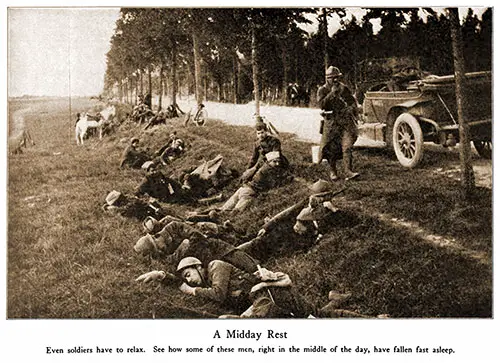
A Midday Rest. Even Soldiers Have to Relax. See How Some of These Men, Right in the Middle of the Day, Have Fallen Fast Asleep. Harper's Pictorial Library of the World War, Volume 11, 1920. GGA Image ID # 18c716aaef
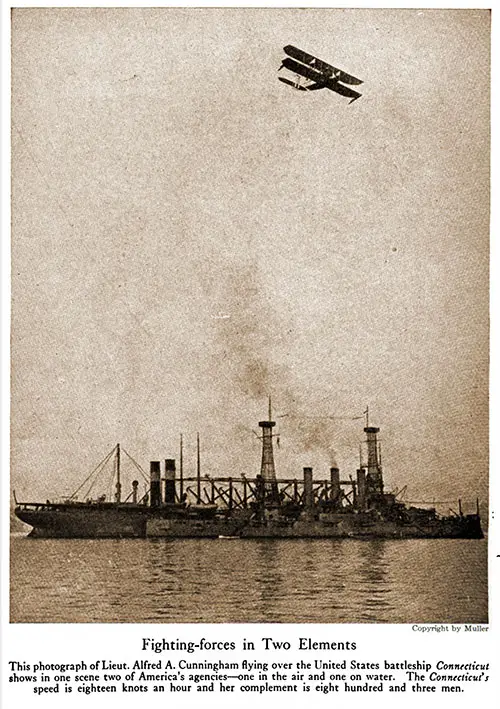
Fighting-Forces in Two Elements. This Photograph of Lieut. Alfred a. Cunningham Flying Over the United States Battleship USS Connecticut Shows in One Scene Two of America’s Agencies—One in the Air and One on Water. The USS Connecticut’s Speed Is Eighteen Knots an Hour, and Her Complement Is Eight Hundred and Three Men. Photograph © Enrique Muller. Harper's Pictorial Library of the World War, Volume 11, 1920. GGA Image ID # 18c71ceaff

Fire a Torpedo at One of the Ships of the Allied Convoy. Illustration © Underwood & Underwood. Harper's Pictorial Library of the World War, Volume 11, 1920. GGA Image ID # 18c76614d8
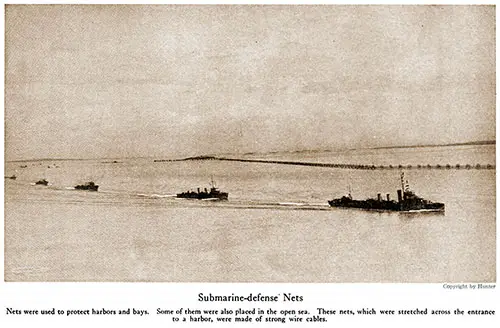
Submarine-Defense Nets. Nets Were Used to Protect Harbors and Bays. Some of Them Were Also Placed in the Open Sea. These Nets, Which Were Stretched Across the Entrance to a Harbor, Were Made of Strong Wire Cables. Photograph © Hunter. Harper's Pictorial Library of the World War, Volume 11, 1920. GGA Image ID # 18c7e85561
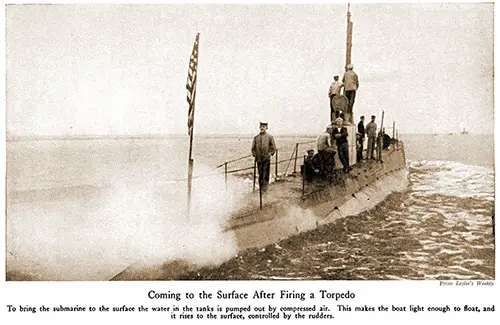
The Submarine Surfaces After Firing a Torpedo. Compressed Air pumps Out the Water in the Tanks To Bring the Submarine to the Surface. This Makes the Boat Light Enough to Float, and It Rises to the Surface, Controlled by the Rudders. Photograph Courtesy of Leslie's Weekly. Harper's Pictorial Library of the World War, Volume 11, 1920. GGA Image ID # 18c8019e9b

A crewman on Conning Tower Waits for the Command to Dive. When a Boat Is to Be Submerged the Ballast-Tanks, or Compartments, Are Opened to the Sea and Must Be Completely Filled. The Submarine Is Then in What Is Called "Diving Trim," Ready to Be Sent Under the Water. Photograph © Muller. Harper's Pictorial Library of the World War, Volume 11, 1920. GGA Image ID # 18c810c669

A Submarine With the Conning Tower and Periscope Showing. From a distance, This Might Look Just Like a Broomstick. When the British Boats Tried to Ram Submarines Which Showed Themselves a Bit Above the Water, the Germans Placed False Periscopes in the Ocean, When Rammed, Exploded a Mine Sent the Boat to the Bottom of the Sea. Photograph © Enrique Muller. Harper's Pictorial Library of the World War, Volume 11, 1920. GGA Image ID # 18c8485166

A Christmas Card for the Kaiser. Illustration Shows an Army Sargent Writing "A Merry Christmas to Bill From Uncle Sam," With a Skull and Crossbones Below It. Painting by Tony Sarg. Harper's Pictorial Library of the World War, Volume 11, 1920. GGA Image ID # 18c89b55db
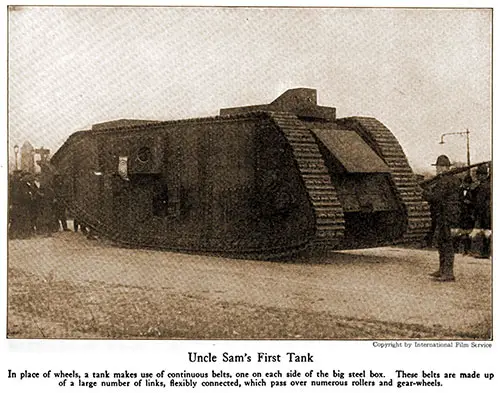
Uncle Sam’s First Tank. In Place of Wheels, a Tank Makes Use of Continuous Belts, One on Each Side of the Big Steel Box. These Belts Are Made up of a Large Number of Links, Flexibly Connected, Which Pass Over Numerous Rollers and Gear-Wheels. Photograph © International Film Service. Harper's Pictorial Library of the World War, Volume 11, 1920. GGA Image ID # 18c957f585

General Joffre - the Smiling Victor of the Marne. "Papa Joffre" Was Not a Politician, and the French Politicians Rather Crowded Him Into the Background. But on 14 July 1919, in Celebrating Their Victory, the French People Showed Unmistakably That the Hero of the Marne Held a First Place in the Hearts of His Countrymen. Photograph Courtesy of Red Cross Magazine. Harper's Pictorial Library of the World War, Volume 11, 1920. GGA Image ID # 18c95dd90a

A Battleship Takes Target Practice. The Energy Behind a Naval Shell Had to Be Tremendous, for the Battleships Used in the Great War Were Covered With Plates of the Hardest and Toughest Steel. Photograph © Enrique Muller. Harper's Pictorial Library of the World War, Volume 11, 1920. GGA Image ID # 18c990c17a

Making the Aerial Messengers of Death. Women in a French Factory Attaching the Wings on Bombs That Are Dropped From Airplanes. The Wings Steady the Bombs in Their Falling Downward. These Women Are Using the Oxy-Acetylene Process of Welding, in Which a Blast of Oxygen-Gas Mingles With the Acetylene-Gas in the Torch and Creates a Heat That Melts Steel as Tallow Melts in an Ordinary Flame. They Wear Goggles to Protect Their Eyes From the Glare and Flying Sparks. Photograph © Underwood & Underwood. Harper's Pictorial Library of the World War, Volume 11, 1920. GGA Image ID # 18ca014729

The Most Popular Red Cross Poster. Why Do You Think That people liked this Poster So Much? It Is Because the fighting left thousands of Children Without Mothers During the War, and It Was Then That the Red Cross Had to Step in and Be a Mother to Them All. Harper's Pictorial Library of the World War, Volume 11, 1920. GGA Image ID # 18ca185dd8

King George on an Inspection Tour of British Industries. Great Britain's Monarch and Some of His British Officers Are Examining the New Masks for Horses. Photograph © International Film Service. Harper's Pictorial Library of the World War, Volume 11, 1920. GGA Image ID # 18ca1f9c71

British Gas Masks for Horse and Man. Both Transport-Wagon and Artillery Horses Were Always Supplied With Gas Masks Like Their Drivers When They Entered a Suspected Gas Area. It Was Not Always an Easy Task to Get Them to Wear Them. Photograph © Kadel & Herbert. Harper's Pictorial Library of the World War, Volume 11, 1920. GGA Image ID # 18cb1a9c89

A Symphony in O. D. (Olive Drab). "Music Hath Charms" We Are Told, and This Enjoyable Side of the Soldiers' Life Was Encouraged Under the Leadership of Well-Known Choristers. Photograph Courtesy of Red Crass Magazine. Harper's Pictorial Library of the World War, Volume 11, 1920. GGA Image ID # 18cb25fc73

Helping to Beat the Kaiser. During the War When the German Submarines Were Threatening to Cut off England From the Rest of the World, Every Bit of Food Counted, So These Little Workers Were Really Making Ammunition of War. Photograph © Underwood & Underwood. Harper's Pictorial Library of the World War, Volume 11, 1920. GGA Image ID # 18cb4bb432
Rebecca Lawrence Lowrie, Ed., Harper's Pictorial Library of the World War, Volume XI: Child's Book of the War--Its History and Wonders Told for Young People, New York-London: Harper & Brothers Publishers, 1920. Foreword by Charles W. Eliot, Ph.D., and Introduction by Henry Noble MacCracken.
